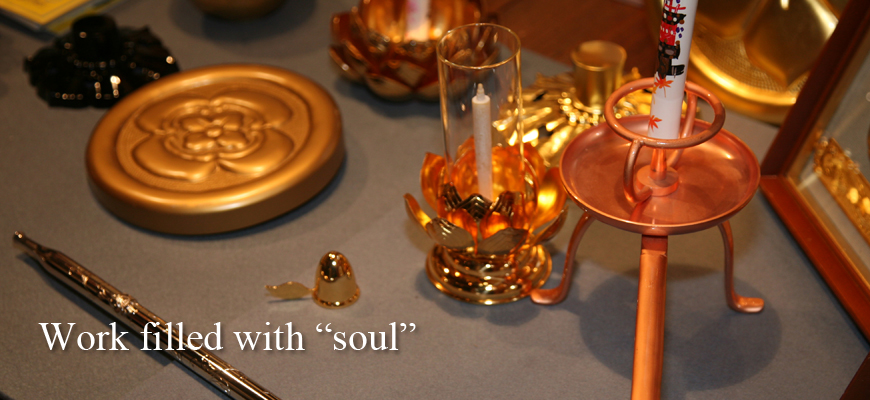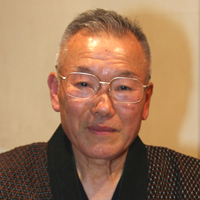
Toshiyuki Kawashima
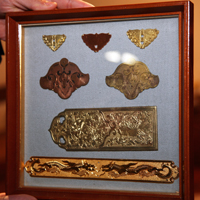
Kawashima also restores cultural properties. When Kan-eiji Temple's ceiling was repaired, he made missing parts (second two parts from the top), of which patterns are engraved after seven sheets of gold leaves are pasted on them with mercury. Compared to "Kin-bari," in which one gold leaf is pasted with Japanese lacquer, this method can produce a deeper gloss.
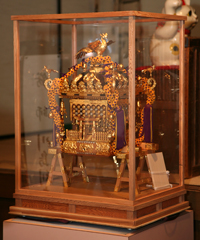
This is the only miniature portable shrine in the world. Craftsmen in seven to eight businesses, including a woodturner, caster, braid maker, goldbeater and lacquerer, took part in creation of the portable shrine. It took about 20 years to create this portable shrine. The size of the pedestal is approximately 18 centimeters, one-tenth of a real portable shrine's size of 182 centimeters.
What is Kazari?
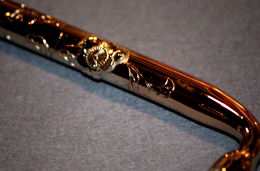
What is a sense of satisfaction for Kazari-shi?
I feel pleasure when I am asked to create difficult things. How can I make it? Although half of the creating process may be painstaking, I feel satisfied when it is finished. There are many ornaments which I created after receiving advice from customers and tried to obtain patents for.
Work
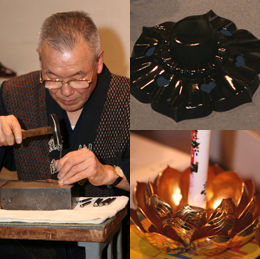
The most common work is to make temple crests. It is also referred to as "shrine crest" or "head temple crest." There are also crests of subordinate shrines and temples. Some temples have two to three different crests. In some cases, benevolent people donate their own crests to temples. I also make metal fittings for Buddhist memorial tablets and family altars. Instead of standard Buddhist memorial tablets, I sometimes create rather superior tablets out of silver. When a certain family temple was newly built, I made metal fittings for its gate. I had been busy making 30 lanterns since the end of last year. I have made a total of 55 lanterns lining up at Kandamyojin Shrine, which I started making from 2004.
How did Kawashima become Kazari-shi?
Could you tell me why you became Kazari-shi?
I graduated from a junior high school right after the war in 1951. It was the time when people said, "It is better to acquire useful skills than to study at schools." Although my father said, "You should study at a high school," I did not. A person who came to my house in Gifu Prefecture and helped my family plant rice asked me, saying, "Someone in Tokyo is seeking an apprentice. Are you willing to go to Tokyo?" Then, I readily accepted the offer, and came to Tokyo. I was determined to be a craftsman. I served my apprenticeship for 10 years. Then, I was trained by some masters for about two years, and became independent. After that, my business went splendidly. I had worked from 7:00 a.m. to around 7:00 p.m. from the age of 35 or 36 to 55. I suffered chronic shoulder pains four times. It was so painful that I could not sleep. The pain persisted up to a half year.
How many Kazari-shi do exist in the present day?
There are about five to seven in Tokyo. They do not have lateral relations. There used to be about 50 Kazari-shi in the Kansai Region, but now the number drops by about half. When I visited their houses, I could just talked with them at entrances, and could not see their work spaces because "machiya" houses in Kyoto are long and narrow. They did not show their skills. Moreover, division of labor is established in the Kansai Region, so each craftsman is doing different work, such as cutting materials, carving patterns, and putting parts together. Craftsmen cannot be independent in that system. Secret skills are handed down only to their eldest son.
Kawashima's works
Could you tell me about the creation process?

Could you tell me about materials?
Some wealthy people have asked me to make their family crests out of gold or silver. Crests made of copper or brass have usually been ordered by temples and shrines. Those crests are plated. Copper is softer, so it is easy to engrave and bend. Brass is hard. Portable shrines can be decorated only with brass because copper becomes darker when it is finished. I make pipes out of brass. I plate pipes with rhodium. They are glossy, aren't they? Silver is more dull. Moreover, rhodium and chromium do not peel off. I think, nowadays, rhodium is mainly used. Chromium is very expensive. It costs money even when disposing of water that is used for purification. Rhodium also gives off smoke when it melts. So, nowadays, metal plating factories also do not melt those metals by themselves. I have recently only used commercially available metals. Therefore, colors of those metals have also changed.
Could you tell me about patterns?
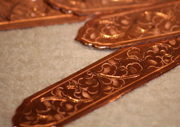
Tools
Could you tell me about tools that you are using?
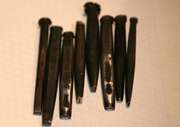
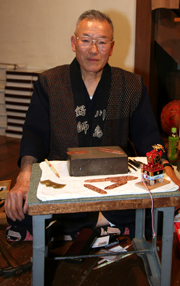

Toshiyuki Kawashima

Kawashima also restores cultural properties. When Kan-eiji Temple's ceiling was repaired, he made missing parts (second two parts from the top), of which patterns are engraved after seven sheets of gold leaves are pasted on them with mercury. Compared to "Kin-bari," in which one gold leaf is pasted with Japanese lacquer, this method can produce a deeper gloss.

This is the only miniature portable shrine in the world. Craftsmen in seven to eight businesses, including a woodturner, caster, braid maker, goldbeater and lacquerer, took part in creation of the portable shrine. It took about 20 years to create this portable shrine. The size of the pedestal is approximately 18 centimeters, one-tenth of a real portable shrine's size of 182 centimeters.
What is Kazari?

Small metal ornaments, such as an ornamental hairpin and metal fittings, are called "Kazari." In the past, craftsmen who create lantern ornaments, pipes and others were called "Kazari (written in hiragana) -shi." In the present, "Kazari-shi" written in Chinese characters are used for referring to craftsmen who create metal ornaments for shrines and temples. On the other hand, "Kazari-shi" written in different Chinese characters are used for referring to craftsmen who create metal ornaments for hina dolls, dolls for the Boys' Festival, and others.
What is a sense of satisfaction for Kazari-shi?
I feel pleasure when I am asked to create difficult things. How can I make it? Although half of the creating process may be painstaking, I feel satisfied when it is finished. There are many ornaments which I created after receiving advice from customers and tried to obtain patents for.
Work

The most common work is to make temple crests. It is also referred to as "shrine crest" or "head temple crest." There are also crests of subordinate shrines and temples. Some temples have two to three different crests. In some cases, benevolent people donate their own crests to temples. I also make metal fittings for Buddhist memorial tablets and family altars. Instead of standard Buddhist memorial tablets, I sometimes create rather superior tablets out of silver. When a certain family temple was newly built, I made metal fittings for its gate. I had been busy making 30 lanterns since the end of last year. I have made a total of 55 lanterns lining up at Kandamyojin Shrine, which I started making from 2004.






